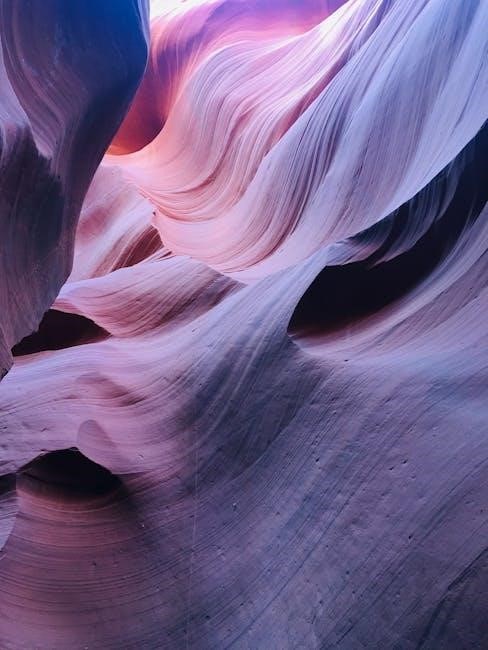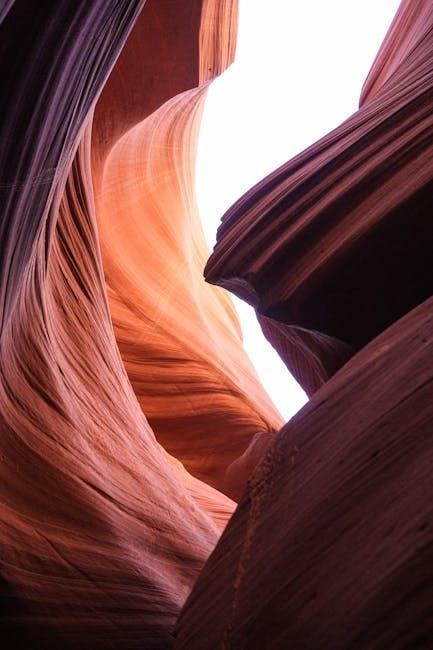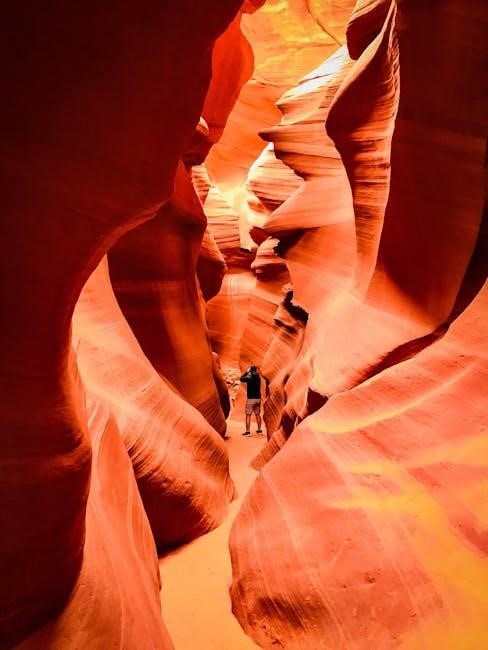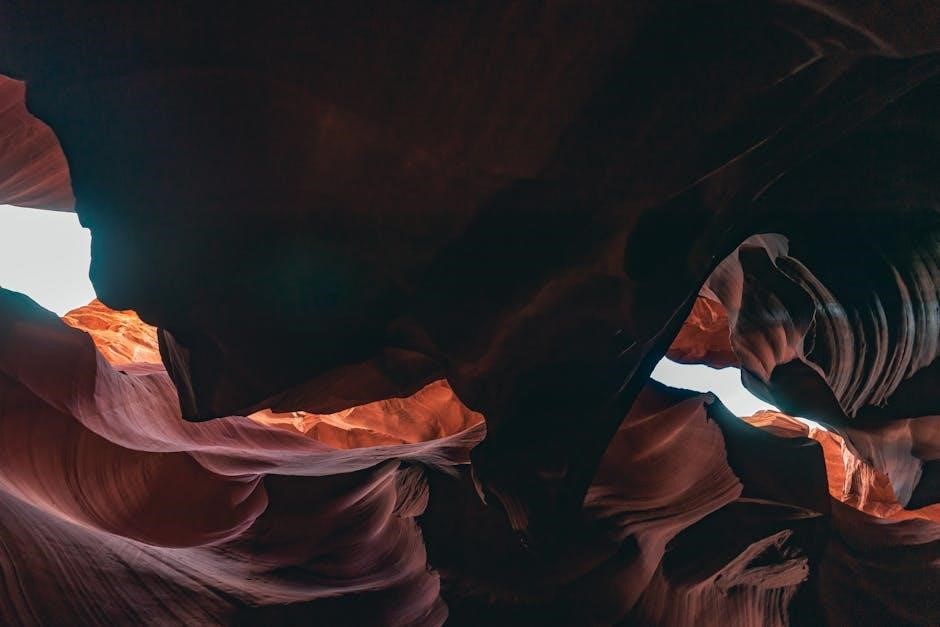Antelope Canyon, a stunning natural wonder, requires guided tours to explore its breathtaking landscapes․ While hiking without a guide is restricted, alternatives like kayak trips offer unique access․
Overview of Antelope Canyon’s Natural Beauty
Antelope Canyon is renowned for its extraordinary slot canyon formations, carved by centuries of erosion․ The canyon’s swirling red and orange rock layers create a mesmerizing display of natural artistry․ Located near Page, Arizona, it consists of two main sections: Upper and Lower Antelope Canyon․ The Upper Canyon, with its iconic light beams, is a favorite for photographers, while the Lower Canyon offers a more adventurous, V-shaped descent․ Together, they form one of the most visually stunning landscapes in the American Southwest, attracting visitors worldwide to marvel at their beauty and geological significance․
Importance of Guided Tours in Antelope Canyon
Guided tours are essential for exploring Antelope Canyon due to its protected status under the Navajo Nation․ Guides ensure safe navigation through the canyon’s narrow passages and fragile formations․ They also provide insights into the cultural and geological significance of the area, enhancing the visitor experience․ Without a guide, access is restricted to prevent environmental damage and ensure visitor safety․ Additionally, guides help protect the site from vandalism, preserving its natural beauty for future generations․ Their expertise is crucial for a responsible and enriching visit to this incredible natural wonder․

Legal and Regulatory Requirements
Antelope Canyon is regulated by the Navajo Nation, requiring guided tours for access․ These tours protect the area’s environmental and cultural heritage while ensuring visitor safety․
Navajo Nation Regulations and Protected Areas
Antelope Canyon is protected under Navajo Nation regulations, requiring all visitors to access the area through authorized guides․ These rules safeguard the canyon’s natural and cultural heritage, ensuring its preservation for future generations․ Unauthorized access is strictly prohibited, and visitors must adhere to guided tours to maintain environmental integrity and respect Navajo traditions․ The Navajo Parks and Recreation Department enforces these regulations to protect sensitive lands and prevent vandalism, emphasizing the importance of responsible tourism․ By following these guidelines, visitors contribute to the conservation of this iconic natural wonder while experiencing its unparalleled beauty․
Mandatory Guided Tours for Access
Accessing Antelope Canyon without a guide is prohibited due to Navajo Nation regulations․ Authorized tours are the only way to explore the canyon, ensuring visitor safety and environmental protection․ These tours, led by knowledgeable guides, provide insight into the canyon’s cultural and natural significance․ While some alternatives, like kayak trips, allow independent exploration of certain areas, hiking the canyon itself still requires a licensed guide․ This rule helps preserve the fragile ecosystem and respect the land’s cultural heritage․ Violating these regulations can result in fines or prohibited access, emphasizing the importance of adhering to guided tour requirements․

Alternatives to Traditional Guided Tours
Kayak trips and hiking via Lake Powell offer unique access to Antelope Canyon without a Native guide, providing an adventurous way to explore its stunning landscapes independently․
Accessing Antelope Canyon via Lake Powell
Lake Powell offers an alternative route to Antelope Canyon, allowing visitors to explore without a traditional guide․ By kayaking to the canyon’s entrance, adventurers can paddle through serene waters and hike up the canyon’s trails․ This method provides a unique, self-guided experience, enabling visitors to immerse themselves in the natural beauty of the canyon at their own pace․ However, it’s important to note that while this approach avoids a Native guide, it still requires adherence to Navajo Nation regulations and environmental guidelines to preserve the area’s fragile ecosystem and cultural significance․
Kayak Trips and Hiking Without a Native Guide
Kayak trips to Antelope Canyon offer a unique way to explore its lower sections without a Native guide․ Visitors can paddle through Lake Powell, then hike up the canyon’s trails, experiencing its natural beauty firsthand․ This option provides more independence but still requires compliance with Navajo regulations․ The serene waters and stunning rock formations make the journey rewarding․ However, safety and environmental preservation remain crucial, ensuring this incredible landscape remains intact for future generations․ This alternative allows adventurers to connect with nature while respecting the protected area’s guidelines and cultural heritage․
Safety Concerns and Guided Tours
Guided tours are essential for safety, as they navigate risky terrain and prevent accidents, ensuring visitor well-being while protecting the fragile environment of Antelope Canyon․
Why Guides Are Essential for Visitor Safety
Guided tours are crucial for visitor safety in Antelope Canyon, as guides possess expert knowledge of the terrain and potential hazards․ They navigate narrow passages, avoid dangerous drop-offs, and ensure safe climbing․ Without a guide, visitors risk getting lost or injured in the canyon’s complex formations․ Guides also monitor weather conditions to prevent flash flood risks, a significant danger in slot canyons․ Their presence ensures adherence to safety protocols and emergency preparedness, making them indispensable for a secure and enjoyable experience․ Mandatory tours safeguard both visitors and the fragile environment, emphasizing the importance of guided exploration․
Risk of Vandalism and Environmental Protection
Guided tours play a vital role in preventing vandalism and protecting Antelope Canyon’s fragile environment․ Without supervision, the canyon’s delicate rock formations and cultural sites are at risk of damage․ The Navajo Nation has implemented strict regulations to preserve the area, and guides enforce these rules to ensure visitor compliance․ Unauthorized access increases the likelihood of vandalism, which harms both the natural beauty and cultural significance of the canyon․ By requiring guided tours, the Navajo Nation safeguards this incredible resource for future generations, maintaining its integrity and beauty for all to enjoy responsibly․
Cost Implications of Guided Tours
Guided tours in Antelope Canyon range from $40 to $80, with deluxe options available․ Prices often include taxes and Navajo permits, ensuring a protected and safe experience․
Price Range for Lower Antelope Canyon Tours
Guided tours for Lower Antelope Canyon typically range from $40 to $80 per person, depending on the tour type and duration․ Basic tours usually cost around $40, while deluxe or photography-focused tours can go up to $80․ These prices often include taxes and the required Navajo Nation permit․ Some tour operators may offer additional amenities, such as transportation or equipment rentals, which can affect the total cost․ It’s important to check with authorized tour providers for the most accurate pricing and inclusions․ Booking in advance is recommended to secure availability, especially during peak travel seasons․
Inclusions and Variations in Tour Packages
Antelope Canyon tour packages vary, offering options to suit different preferences and needs․ Basic tours typically include admission, a guided walk, and insight into the canyon’s history․ Deluxe tours may add extras like transportation, while photography tours provide extended time for capturing images․ Some packages offer small group sizes or specialized guides knowledgeable in photography techniques․ Variations cater to visitors seeking unique experiences, such as sunrise or sunset tours for optimal lighting․ Additional inclusions might include water and snacks, though specifics depend on the tour operator․ These variations ensure visitors can choose an experience that aligns with their interests and goals․
Planning Your Visit
Plan your visit by booking a guided tour in advance, ensuring smooth access and adherence to regulations for exploring Antelope Canyon’s stunning natural beauty safely․
Do You Need Reservations for Guided Tours?
Reservations for Antelope Canyon tours are highly recommended, though not always required․ Booking in advance ensures availability, especially during peak seasons․ While some operators allow walk-ins, securing a spot beforehand guarantees a smooth experience․ This is particularly important for popular times like midday when light beams illuminate the canyon․ Many visitors opt to plan ahead to avoid last-minute disappointments, ensuring they can fully enjoy the natural beauty and unique formations of this iconic destination․ Reservations also help tour operators manage group sizes and maintain a safe, organized environment for all visitors․
Benefits of Booking Tours in Advance
Booking Antelope Canyon tours in advance offers numerous benefits․ It ensures availability, especially during peak seasons when demand is high․ Visitors can avoid last-minute disappointments and secure preferred time slots, ideal for capturing iconic light beams․ Advanced booking also allows tourists to plan their itineraries better, coordinating with other activities; Many operators provide additional perks, such as priority access or discounted rates, for early bookings․ This proactive approach enhances the overall experience, making it more enjoyable and stress-free․ Planning ahead is crucial to fully appreciate the canyon’s natural splendor and unique geological features․

Upper vs․ Lower Antelope Canyon
Upper Antelope Canyon is more accessible, with smoother trails, while Lower Antelope Canyon features a V-shape and stairs․ Both require guided tours for safe exploration․
Differences in Accessibility and Requirements
Upper Antelope Canyon is more accessible, with smoother trails and fewer physical demands, while Lower Antelope Canyon features a V-shaped structure and requires navigating stairs․ Both canyons mandate guided tours due to Navajo Nation regulations, ensuring visitor safety and environmental protection․ Upper Antelope Canyon is often preferred for its easier terrain, while Lower Antelope Canyon offers a unique, adventurous experience․ Regardless of the canyon, visitors must book tours through authorized operators to gain entry, as self-guided exploration is strictly prohibited to preserve the site’s natural and cultural integrity․
Comparing Tour Experiences in Both Canyons
Upper Antelope Canyon offers smoother trails and is more accessible, making it ideal for photography tours․ Lower Antelope Canyon provides a more adventurous experience with its V-shaped structure and stair climbs․ Both require guided tours, ensuring safety and environmental preservation․ While Upper Canyon is favored for its ease and scenic beauty, Lower Canyon attracts those seeking a thrilling hike․ Guides play a crucial role in both, sharing cultural insights and helping visitors navigate․ Each canyon delivers a unique experience, but both emphasize the importance of responsible tourism and respecting Navajo Nation regulations to protect this natural wonder․
Environmental and Cultural Significance
Antelope Canyon holds deep cultural and environmental value, protected by the Navajo Nation․ Guided tours ensure preservation of its fragile ecosystem and rich heritage, promoting responsible tourism․
Preserving the Natural and Cultural Heritage
Preserving Antelope Canyon’s natural and cultural heritage is paramount․ The Navajo Nation enforces strict regulations to protect the site’s fragile ecosystem and sacred cultural significance․ Mandatory guided tours ensure responsible tourism, preventing vandalism and environmental damage․ Guides educate visitors about the canyon’s history and importance, fostering respect for its natural beauty․ By limiting access and adhering to guided tours, the Navajo Nation safeguards the canyon for future generations, maintaining its pristine condition and cultural integrity․ This approach balances tourism with conservation, ensuring Antelope Canyon remains a cherished natural and cultural treasure․
Role of Guides in Educating Visitors
Guides play a crucial role in educating visitors about Antelope Canyon’s history, geology, and cultural significance․ They provide insights into the canyon’s formation and the Navajo Nation’s connection to the land․ Guides also emphasize the importance of preserving the environment and respecting sacred sites․ By sharing their knowledge, they promote responsible tourism and ensure visitors leave with a deeper appreciation for the canyon’s natural and cultural heritage․ This educational aspect enhances the visitor experience while fostering a sense of stewardship for the fragile and protected area․
Guided tours are essential for exploring Antelope Canyon safely․ Both Upper and Lower canyons require authorized guides․ Kayak trips offer limited access but still have restrictions․
Final Thoughts on Visiting Antelope Canyon
Visiting Antelope Canyon is a breathtaking experience, but it requires careful planning․ Guided tours are mandatory for both Upper and Lower canyons, ensuring safety and preservation․ While traditional hikes without guides are restricted, alternatives like kayak trips to Lake Powell offer unique access to Lower Antelope Canyon․ These options allow visitors to explore the canyon’s stunning natural beauty while adhering to Navajo Nation regulations․ Regardless of the method, respecting the land and its cultural heritage is essential․ Booking tours in advance and following guidelines helps protect this incredible wonder for future generations to enjoy responsibly․
